

| Archive Blog Cast Forum RSS Books! Poll Results About Search Fan Art Podcast More Stuff Random |
|
Classic comic reruns every day
|
1 {photo of fireworks}
1 Caption: The Luminiferous Aether
|
First (1) | Previous (3240) | Next (3242) || Latest Rerun (2895) |
Latest New (5380) First 5 | Previous 5 | Next 5 | Latest 5 Annotations theme: First | Previous | Next | Latest || First 5 | Previous 5 | Next 5 | Latest 5 This strip's permanent URL: http://www.irregularwebcomic.net/3241.html
Annotations off: turn on
Annotations on: turn off
|
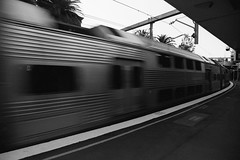 Light from this train might be travelling faster than light from the sun! |
If you were on a train[1] moving at 100 kilometres per hour, and you threw a ball towards the front of the train at 100 kilometres per hour, then to a person standing still on the ground outside the train, the ball would be moving at a total of 200 kilometres per hour.[2] Straightforward.
In 1676, within just a few years of Newton's Principia, the Danish astronomer Ole Rømer noticed that the motions of the moons of Jupiter, in particular the eclipses where a moon passed behind the planet, seemed to be occurring several minutes later than expected at some times. He realised that the late eclipses occurred when Jupiter was on the far side of the sun compared to Earth, and that they appeared on time when Earth was nearer to Jupiter. Rømer made the logical deduction that the light from the moons must be taking longer to reach Earth when it was further away. This was not a trivial thing; up until this time most people had assumed that you see things when they happen. In other words, that light travels instantaneously, or infinitely fast.
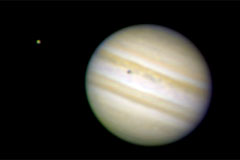 Jupiter and its moon Europa seen through an amateur telescope. Creative Commons Attrbitution-Share Alike image by Flickr user gerlos. |
The result was that light travelled at approximately 300,000 kilometres per second. Incredibly fast, and not of much consequence here on Earth where no two points are more than 20,000 kilometres apart (measured along the surface). But in space the distances are much bigger, and light from the sun, far from arriving at Earth almost instantly, takes a bit over eight minutes to reach us. Light from Jupiter, including views of eclipses of its moons, takes up to sixteen minutes longer to reach us when the planet is on the far side of the sun, compared to when it's on the same side as Earth.
The nature of light remained mysterious for over a hundred further years, until James Clerk Maxwell formulated his fundamental equations of electromagnetism and realised that they implied that light was a propagating wave of electricity and magnetism. The next logical step, given this discovery, was to wonder what light was waves in. In the same way that water waves need water, and sound waves need air, it made sense that light waves needed some sort of physical medium to propagate through. Waves, after all, move by wiggling bits of a medium around. Water waves are nothing but the sloshing around of water. Sound waves are similarly the movement of molecules in the air. What were light waves moving around as they propagated?
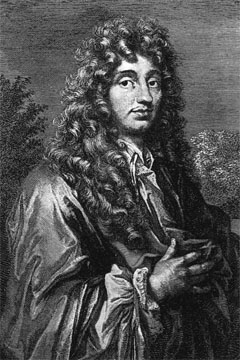 Christiaan Huygens. Public Domain image from Wikimedia Commons. |
By the 19th century, the wave nature of light was well established, and the luminiferous aether, while still evading detection, was almost taken for granted. By providing a medium for light to travel through, the aether also provided the baseline for the speed of that light. In other words, the (roughly) 300,000 kilometre per second speed of light was the speed of light measured with respect to the aether. If you were on a train moving at 100 kilometres per hour through the aether, then you would measure the speed of light going past you in the same direction to be (300,000 km/s) minus (100 km/h). Now 100 km/h is 0.0278 km/s, which is close to a hundred thousandth of a percent of the speed of light. Clearly this would be difficult to measure, and so it was. Nobody had instruments accurate enough to measure such changes in the speed of light.
The apparent changes in the speed of light might be measurable, if only you could move fast enough. A train would not do. You'd have to move thousands of times faster than that to have a chance. But this was the 19th century - a train was about the fastest thing available.
Or was it? Physicists in the mid-19th century realised that we had ready access to an object moving at a little over 100,000 kilometres per hour, which is close to 30 kilometres per second. What is this object? It's all around you! The Earth moves at this speed in its orbit around the sun.
If you assume the aether is still with respect to the sun, then the Earth moves through it at almost 30 km/s, which is about a hundredth of a percent of the speed of light. You might have a chance of measuring this difference in the speed of light in different directions. And if the sun itself is moving through the aether, you can account for that by doing experiments six months apart, when the Earth is moving in the opposite direction through space, to see if there's any difference in your measurements. The main problem with this insight was that, in the mid-19th century, we still had no way of measuring the speed of light to an accuracy of better than a few percent. So the experiment could not be done.
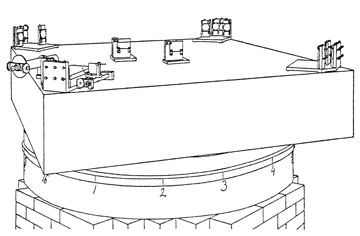 Michelson-Morley experiment apparatus. Public Domain image from Wikimedia Commons. A photo of the apparatus is viewable in the Caltech Archives. |
Michelson and Morley's apparatus consisted of a series of mirrors that reflected light from a source along various paths, before bringing them together at a viewing screen. For stability and to isolate it from vibrations, the equipment was mounted on a huge slab of sold stone, which was floating in a pool of mercury. When light waves from a single source travel different paths and then are brought together again, the waves interact with one another to produce what is known as an interference pattern[3]. In Michelson and Morley's apparatus, the interference pattern was a series of light and dark bars on the viewing screen. The critical thing about this pattern was that if the distance the light travelled along each of the paths changed, then the interference bar pattern shifted. Or equivalently, and this is the critical part, if the speed of light moving along the paths changes, it will also cause a relative shift in the arrival times of the beams at the viewing screen, and so also shift the interference pattern.
The clever thing about an instrument like this, called an interferometer, is that the shift in the interference pattern is much, much more sensitive to the changes in light travel distance or speed than any direct method of measuring those changes. It's like a high-powered magnifier that reveals the existence of tiny tiny changes in the light travel. This principle had been known for many years.
 Light paths through the Michelson-Morley interferometer. Public Domain image from Wikimedia Commons. |
Think about this for a minute. If the Earth is moving through the aether and the speed of light is fixed with respect to the aether, then the light travel speed with respect to the Earth in the direction that the Earth is moving is different to the light travel speed with respect to the Earth in a direction 90° to the Earth's motion. If the arms of the interferometer correspond to these directions, the light travel time along the arms is different, and you'll get one particular interference bar pattern. Now if the arms are rotated 90° so that they swap positions, the difference in light travel time will be swapped, and the interference bar pattern will shift! The arms might happen not to be lined up exactly with the direction of Earth's motion through the aether, but by repeating the experiment at different times of day and year, you can do the geometry and figure out the right answer.
Earth's speed moving through the aether was reckoned to be something like 30 km/s. Michelson and Morley's interferometer was sensitive enough to measure changes in the speed of light as small as about 4 km/s. So they were confident of seeing the movement of the interference bars they expected, to confirm all of the theories about the existence of the luminiferous aether. Excitedly, they made measurements with their apparatus. They recorded the interference bars, then, breaths held no doubt, they spun the device around on its pool of mercury.
They observed nothing. No change whatsoever.
Over months of repeated observation, they never saw any change in the interference bars at all.
This came as a shock. They had the best, most modern scientific theory available. It predicted unequivocally what they should see. The experiment was carefully designed and carefully carried out. And the results refused to fit the theory.
Michelson and Morley published their result, or lack of result, and moved on to other work. Michelson returned to try to detect the aether again in 1900, working this time with Dayton Miller. Miller was a firm believer in the aether and figured that a more precise experiment, more carefully designed and executed, would measure the Earth's motion through the aether. Over the next four years he worked with Michelson on an improved interferometer. The cross was bigger, the light paths were longer, the expected interference bar shifts bigger, giving them a better chance of seeing changes even smaller than before.
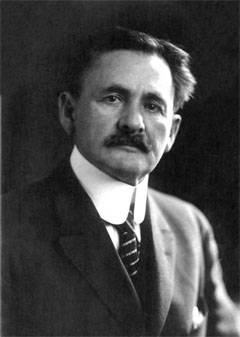 Albert Michelson. Public Domain image from Wikimedia Commons. |
This was a huge puzzle. They had effectively disproved the existence of the luminiferous aether. It could not exist, or they would have seen the evidence for it. Without the aether, all theories of the propagation of light up to this point were thrown out the window. Physicists realised they did not really understand light at all.
This situation lasted just another year, until 1905. Albert Einstein figured out what was wrong with the assumptions everyone before him had made about the nature of light. He changed those assumptions to make the theory of light consistent with what was observed - consistent with Michelson and Morley's experiment.
The Michelson-Morley experiment has been called the "greatest failed experiment of all time". But it was not a failure. Yes, it failed utterly to detect what they expected to see, but this is what makes it so significant. It changed the way we think about a fundamental aspect of the universe, by shattering our previously held illusions. It set up a revolution in physics.
The process of science cannot prove anything. But it can, very easily, disprove things. A single observation, which is able to be reliably duplicated, can collapse an entire fortress of ideas that seemed utterly impenetrable before. The best scientific theories are the ones that survive this process - experiments that could disprove them fail to do so. Einstein's special theory of relativity, the replacement that he devised in 1905 for the disproven aether, has survived every assault on it to the present day. Many, many experiments have been devised to test Einstein's theory, and they have all produced results that agree with its predictions.
In some sense, these are the failed experiments. They failed to disprove Einstein. Michelson and Morley's experiment, through observing nothing, disproved 250 years of thought about the nature of light. Failure? No, it was one of the greatest successful experiments ever devised. In 1907, a mere two years after Einstein reformulated the theory of light to match Michelson's observations, Albert Michelson was awarded the Nobel Prize in physics.
Ya don't get that from a failure.
[2] There should totally be a version of baseball with train tracks instead of a pitcher's mound.
[3] I've talked about interference patterns of light waves in an older annotation. You may want to refresh your memory a bit there.
|
LEGO® is a registered trademark of the LEGO Group of companies,
which does not sponsor, authorise, or endorse this site. This material is presented in accordance with the LEGO® Fair Play Guidelines. |